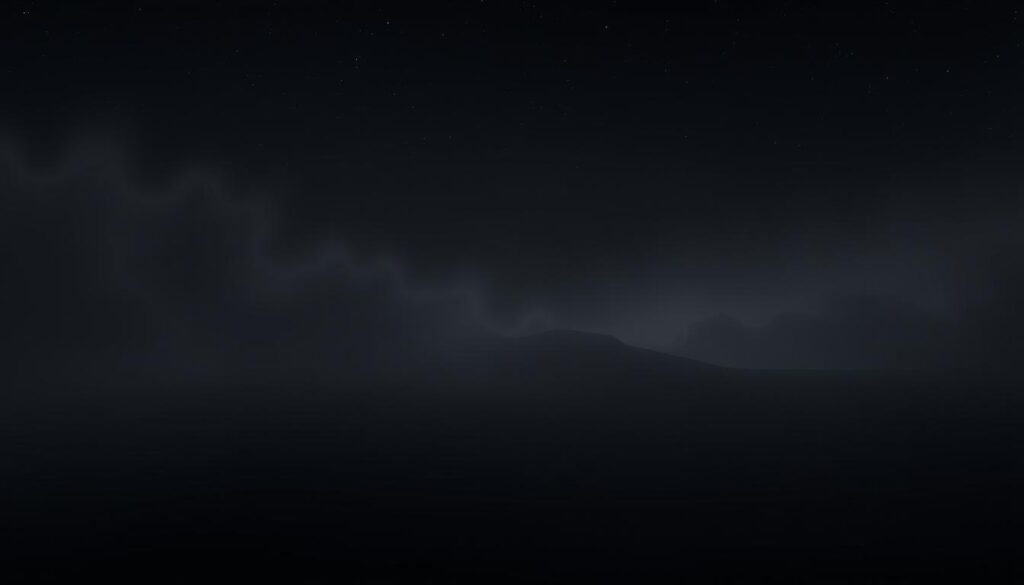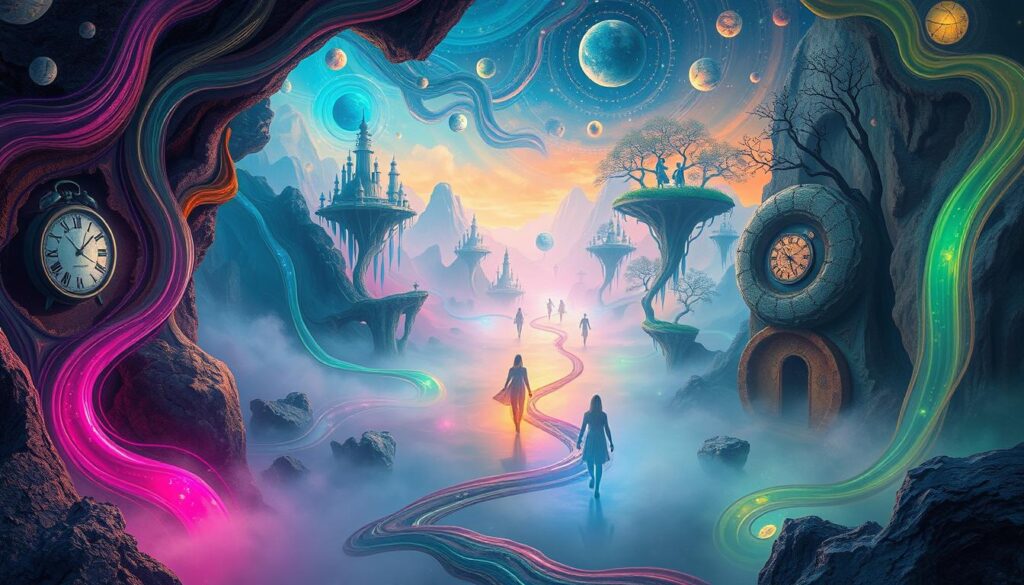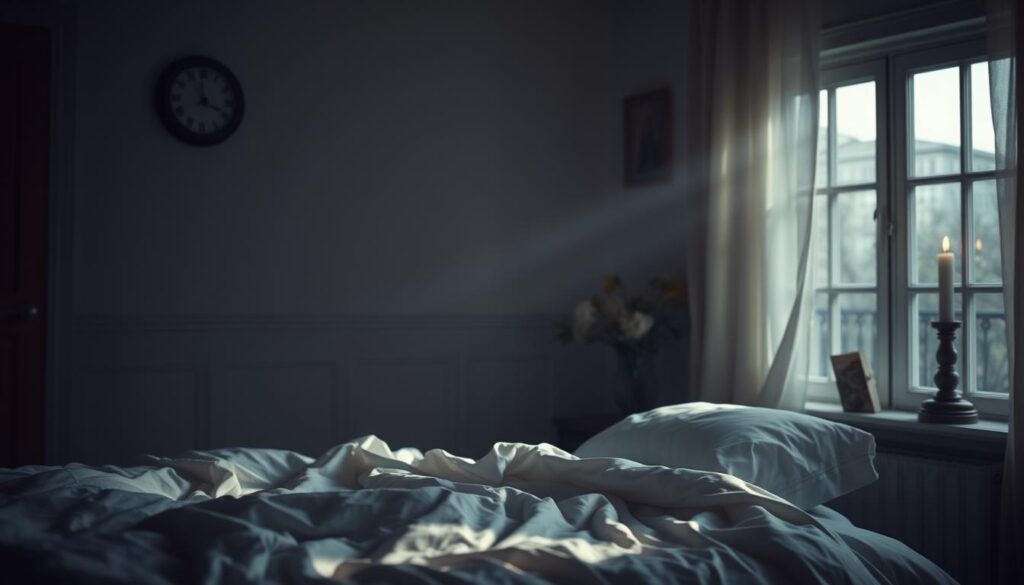As you sit in the hospital room, holding your grandmother’s hand, you wonder what will happen when she passes away. Death is a mystery that both unsettles and intrigues us. Will her soul go to heaven? Could she be reborn? Or is there just darkness after?
The idea of life after death has been a key part of many beliefs for a long time. In Christianity, it’s about heaven and hell. In Hinduism, it’s about being reborn. This idea has always caught our attention. But what do science and our own experiences say about what happens when we die?
Key Takeaways
- The uncertainty surrounding death can be both unsettling and intriguing.
- The concept of the afterlife has long been a central tenet of many religions and spiritual beliefs.
- Near-death experiences and reports of communication with deceased loved ones have fueled beliefs in the afterlife.
- However, some people believe that existence simply ceases at death, with no afterlife or continuation of consciousness.
- Exploring one’s subconscious and personal beliefs can provide insights into the mystery of what happens when you die.
Children’s Perspectives on Death
Children face the complex world of life and death. In the counselor’s office, kids in the middle elementary school age often fear death. They worry about dying or not waking up after sleep. Teenagers, on the other hand, think deeply about death, seeking to grasp its meaning.
Loss or Impending Loss of a Loved One
Children also face the loss of someone close, like a family member, friend, or pet. This makes death feel more real to them. It makes them think about their own life and how short it can be.
Development of Views on Death
How children see death depends on how it’s talked about to them. Young kids see death as just the end of life. Older kids and teens learn more about death when it’s linked to an afterlife or spiritual beliefs.
| Age Range | Perspectives on Death |
|---|---|
| Birth to 2 years | Sense the absence of a person but do not comprehend the permanence of death. |
| 3 to 5 years | Begin gaining awareness of death, depending on their life events and exposure. |
| 6 to 9 years | Generally understand that death is final and they won’t see the person again. |
| 9 to 12 years | May have heightened awareness of death and worry that others may die. |
| Tweens and Teenagers | Understand that everyone dies at some point, but may struggle with vulnerability and changes in independence when dealing with grief. |
Children’s views on life and death change as they grow. Knowing how they think and cope can help adults support them. This support is key in helping kids deal with this tough topic.
Beliefs in the Afterlife
Many people find the idea of the afterlife fascinating. It shows our deep desire to know what happens after we die. Different cultures and religions have their own views, but they all share a common goal. They want to understand what comes after life.
The Idea of Heaven
Heaven is a key belief in the afterlife. It’s seen as a place where souls and celestial beings live. Most people think their souls will end up in heaven after death. But only a few know what it’s like there.
Interacting with Souls of Loved Ones
Believing in the afterlife brings hope of meeting loved ones again. Some think they can talk to the souls of those who have passed away in heaven. Others are unsure about how such meetings would work.
Differing Religious Views on Heaven
Heaven means different things to different religions. Patients ask how heaven can exist if religions have different ideas about it. This shows how hard it is for us to fully grasp the mysteries of the afterlife.
“Since religions represent mankind’s attempts to make sense of the world, the guidance they offer may be imperfect and inconsistent.”
Beliefs about the afterlife are very personal. Each person’s journey to understand and accept the unknown is unique.
The Belief of Nothingness After Death
Some people believe that when we die, we just stop existing. They think we won’t feel, think, or see anything after that. This idea makes them think life has no deep meaning or purpose. Yet, this belief can also give them a reason to live fully and enjoy their short lives.
Life’s Fragility and Making the Most of It
A few patients tell the counselor that believing in nothing after death makes life more beautiful. They say life’s shortness pushes them to live in the moment and enjoy every second. This way, they live with urgency and gratitude, not fear.
Acknowledging the Limits of Our Perception
The counselor also talks about how our brains limit what we can see and understand. With the universe’s vastness and death’s mysteries, it’s wise to be unsure about what comes next. We can’t know for sure, so it’s key to accept our limits and stay open to the unknown.

“After a certain high level of technical skill is achieved, science and art tend to coalesce in esthetics, plasticity, and form. The greatest scientists are always artists as well.” – Isaac Asimov
Thinking about nothingness after death shows us how fragile life is and how limited we are in understanding it. By facing the unknown and living fully now, some people find purpose and meaning. This approach helps them deal with the mystery of death.
Uncertainty About the Afterlife
Many of us wonder what happens after we die. This question leaves us with a lot of uncertainty. It makes us think deeply and look inside ourselves for answers.
Exploring the Subconscious for Answers
Some people try to find answers by looking into their subconscious. They use guided interviews to explore their deepest thoughts. They ask questions like, “Did we exist before birth?” and “Will we exist after death?”
These deep thoughts often show that people believe in some kind of life after death. But, the counselor says these beliefs might just be a wish for more life, not a sure fact.
A story about a potion-maker who wonders about life after death is shared. This story helps us think more about the mystery of the afterlife. It also makes us look into our own minds for answers.
“The mystery of what awaits us after death has captivated humanity for centuries. As we navigate this uncertainty, we must be willing to explore the uncharted regions of our own subconscious, for it is there that we may uncover glimmers of insight into the great beyond.”
By thinking deeply and exploring ourselves, we might find comfort in the idea of living on after death. Or we might accept that the afterlife is a big mystery. Either way, it’s a journey we take throughout our lives.

What Happens When You Die?
The Process of Dying
Death is when the body stops working, like breathing, heartbeat, and brain activity. The dying process is a step-by-step event as the body’s vital systems slow down. This can take different amounts of time, based on health, treatments, and the cause of death.
How Long Does It Take to Die?
The time it takes to die varies a lot. For example, sudden cardiac arrest can lead to death in minutes. On the other hand, chronic conditions might extend the dying process over weeks or months. As death gets closer, it becomes clearer through certain signs.
In hospitals, doctors use certain criteria to declare someone dead. These include no pulse, no breathing, not responding, pupils not reacting to light, and no heart sounds. The body’s temperature also drops after death, reaching the air temperature eventually.
Gravity affects the body after death, causing blood to gather in the lower parts. This leads to a reddish-purple color, known as livor mortis, visible within hours. Rigor mortis, or muscle stiffening, starts within two to six hours, affecting the face, jaw, and neck. It then spreads to the rest of the body before relaxing again after 24-48 hours.
“Nearly 1/3 of those who have been clinically dead and revived did not feel anything at all after death, while close to 1/3 experienced a sensation of light and some form of interaction with another being, and about 1/3 felt like they could observe what was happening during their ‘dead’ state without being able to act.”
The dying process and death experiences differ greatly from person to person. Many questions remain about the afterlife and what happens when we die.

Changes in the Body Before Death
The body changes deeply as death approaches. These changes can be hard to see, but knowing about them can comfort you. It helps you care for your loved one better during this tough time.
More Sleep and Less Physical Activity
The dying person may sleep more and move less as their heart and lungs work harder. This is a natural step in the dying process.
Decreased Appetite and Thirst
The dying person often eats and drinks less as their digestive system slows down. This doesn’t mean they’re in pain. Giving them small amounts of water or ice chips can help with dryness.
Inability to Control Bowel and Bladder
Not being able to control bowel and bladder movements can be tough. But it happens as the body winds down. Your care team can help manage this and keep your loved one comfortable and dignified.
Breakdown of Muscles and Skin
The body may lose muscle mass and skin integrity as death nears. This can cause weight loss and make bruises and bedsores more likely. Your care team can prevent and manage these issues with gentle care and proper positioning.
Dealing with these changes is tough, but with help from healthcare professionals and loved ones, you can make sure your loved one stays comfortable and dignified.
Signs of Approaching Death
As death gets closer, people often show clear signs. These signs help us understand the dying process. They also help us support the person in a meaningful way.
Withdrawal and Detachment
One early sign is a growing sense of withdrawal. The dying person might lose interest in things they loved. They may want to be alone, focusing more on their inner world.
Declining or Irregular Vital Signs
As death nears, vital signs like blood pressure and heart rate can change. The skin may look purplish, pale, grey, or mottled. This means death could be very close, in days or hours.
Agitation
Agitation is another sign death is near. The dying person might suddenly feel energetic or agitated. They might try to leave their bed or remove medical devices. This is because their brain sees things differently and feels threatened.
Changes in Perception
The dying person may see or hear things that aren’t there. This can include illusions, hallucinations, or delusions. The brain may release chemicals that make senses stronger as death comes closer.
Knowing these signs helps families and caregivers support the dying. It lets us understand the physical and emotional changes they go through. This way, we can make their final moments peaceful.

The Dying Process
As death approaches, the dying process is deeply personal. People often enter a state like a coma or dream. They may wake up later, not knowing how long they were asleep.
Even if they can’t see or hear, research shows they might still feel loved ones’ touch and hear their voices. This shows the dying process is complex, with the person still sensing things as they fade away.
Changes in Breathing
The dying person’s breathing changes a lot too. Their breaths become irregular and unpredictable. They might make a “death rattle” sound due to saliva in the throat. This change signals the end is near.
These breathing changes are part of dying and can be hard to see. But, they can also be comforting for those close to the person. Knowing about these changes helps caregivers support the dying and comfort them.
“Even when unconscious, the person may still be able to feel comforting touches and hear the voices of loved ones, as touch and hearing are the last senses to go.”
What Happens During Death?
When death occurs, the body’s vital functions stop working. The heart stops beating, breathing stops, and the brain stops working. Some studies suggest that the brain might still show some activity for a few minutes after death. But this doesn’t mean the person is aware or conscious of their death.
Death brings about many changes in the body. The skin starts to look pale, or pallor mortis, within 15 to 20 minutes after death. This happens because blood stops flowing through tiny blood vessels. Then, the body’s temperature drops by about 1.5°F (0.84°C) every hour after death.
About two to six hours after death, the muscles start to stiffen, a condition known as rigor mortis. Bacteria can spread quickly, reaching the liver, spleen, heart, and brain in about 58 hours. How fast the body decomposes can vary. It depends on the cause of death, the environment, and if the body is wearing clothes.
| Physiological Changes After Death | Timeframe |
|---|---|
| Pallor mortis (paling of the skin) | 15 to 20 minutes |
| Decrease in body temperature | 1.5°F (0.84°C) per hour |
| Onset of rigor mortis (muscle stiffening) | 2 to 6 hours |
| Spread of bacteria to internal organs | Approximately 58 hours |
| Decomposition | Several days |
Death is a complex process that involves many physical and biological changes. These changes help us understand what happens during death. They show how the human body reacts when life stops.
After Death: Changes in the Body
When someone dies, their body changes in many ways. These changes help us understand what happens after death.
Muscle Relaxation and Bodily Functions
Right after death, the muscles relax. This means any tension in the body is released. It can cause the body to release fluids because it can’t control them anymore.
Temperature Drop
With no heartbeat, the body’s temperature drops. This is called algor mortis. It depends on the room temperature, clothes, and the person’s size.
Blood Pooling
Gravity makes the blood go down, causing the skin to turn purplish-red. This is livor mortis. It starts about an hour after death and gets worse over time.
Body Stiffening and Loosening
The muscles get stiff, a process called rigor mortis. It starts at the face and moves to the rest of the body. It can last up to 12 hours before the muscles relax as they break down.
These changes might seem strange but are a natural part of death. They help us understand the end of life and what happens to our bodies.
“What happens when you die?”
Dying is a complex and mysterious process. The body changes in many ways when life ends. The pain level often depends on the death cause and pain meds available.
In emergencies, doctors focus on saving lives and easing pain. They work hard to revive people and make them comfortable. When death is near, they focus on comfort care and pain relief.
Hospice care experts are key in making the end of life comfortable. They are skilled in managing pain and symptoms. This helps make dying peaceful for patients and their families.
The body may resist dying at first, but pain levels vary by situation. The aim is to give compassionate and effective care to those transitioning from life to beyond.
| Body Changes After Death | Timeframe |
|---|---|
| Body temperature drops 1-2°F per hour | Until it reaches room temperature |
| Cells start breaking down due to lack of oxygen | Within minutes of death |
| Livor mortis (blood pooling causing skin splotches) | Appears approximately 30 minutes after death |
| Rigor mortis (body stiffening) | Sets in within 3-4 hours, dissipates within 36 hours |
| Skin shrinkage creating illusion of growing nails/hair | Shortly after death |
| Release of putrescine and cadaverine (foul odors) | During decomposition |
| Greenish skin hue due to microbes | Around 18 hours after death |
| Hair falling out | Within 24-48 hours after death |
| Insect attraction and feeding on remaining tissue | Ongoing decomposition process |
| Skeletonization (complete decomposition) | Eventually, in many cases |
The process of dying is profound and complex for both the person and their loved ones. The physical changes are well-known, but what happens after death is still a mystery. This has intrigued humans for centuries.
Does Dying Hurt?
Death can be scary, and many worry about the pain it might bring. Thanks to advances in care, dying is now much more comfortable. This is true for those in palliative and hospice care.
The Survival Instinct and Pain
Our body’s fight-or-flight response can make us feel pain when we’re in danger. This can make dying uncomfortable. But, the pain can vary a lot. It depends on the reason for death and the meds available.
When we’re in an emergency, doctors focus on saving lives and easing pain. They use many methods, like giving painkillers, to keep us comfortable.
Hospice Care for Comfort
Hospice care is for those with terminal illnesses. Experts in hospice care focus on comfort as death nears. Studies show that most palliative care patients have little to no severe symptoms at the end.
But, not everyone gets the care they need. Only about 40,000 people in Australia get hospice care each year. Those in richer areas or in hospitals with good palliative care teams tend to get better pain relief.
It’s natural to fear pain when we think about dying. But, thanks to medical progress and hospice care, dying is becoming more peaceful.
Conclusion
Dying is a natural part of life that connects us all. It’s normal to fear what we don’t know about death. But, learning about the changes that happen before and after can help us feel better.
This knowledge lets us think deeply about our lives and what they mean. It pushes us to live fully and make the most of our time. This can bring comfort to us or our loved ones facing the end.
As people live longer and healthcare gets better, talking about death and what comes next will keep being important. Looking into different beliefs and science helps us understand death better. How we see death is very personal, based on our values and experiences.
Some people believe in an afterlife, while others focus on living in the moment. But the main point is clear: life is valuable, and how we live it matters most. By understanding this, we can face death’s challenges bravely. We can also leave a lasting impact on those we care about.
FAQ
What is the fear of dying and worry about sleeping that children often express?
Children in their middle elementary school years often fear dying and worry about falling asleep. They fear they or their family might die overnight.
How do children develop their views on death?
Children form their views on death based on how it’s explained to them. Young children see death as ending life, unlike when it’s talked about in terms of an afterlife.
What is a common belief about the afterlife that many patients have?
Many patients believe their souls will go to heaven after death. They also think their pets will go to heaven.
What are some patients’ uncertainties about heaven?
Few patients can explain what happens in heaven. They are unsure if they can meet the souls of loved ones there.
How do some patients view the existence of heaven in the context of different religious beliefs?
Some patients wonder how heaven can be real with different religions having different views on the afterlife. The counselor suggests that religions try to make sense of the world, but their guidance might be imperfect and not consistent.
What is the view expressed by a minority of patients about what happens after death?
A minority of patients believe existence ends at death. They think there’s no feeling, thinking, or perception after death.
How do some patients view the lack of existence after death?
Some see life as pointless without inherent meaning. Others believe life’s fragility makes it precious, encouraging us to live fully.
How do some patients feel about the uncertainty of what happens after death?
Some patients don’t know what happens after death. Many find this uncertainty troubling.
How does the counselor explore patients’ subconscious for answers about the afterlife?
The counselor talks to the patients’ subconscious. They ask if they existed before birth and if they will exist after death. Most say yes, which might show their true beliefs or their wishful thinking.
What happens when someone dies?
Death is when the body stops its functions like breathing, heartbeat, and brain activity. The dying process is a series of events as vital systems shut down.
How long does it take to die?
Death’s time frame varies by health, treatments, and the cause. Sudden cardiac arrest can be quick, while chronic conditions may take weeks or months.
What are some of the changes that occur in the body as it prepares for death?
As death approaches, the body changes. It sleeps more and moves less. Appetite and thirst decrease, and bowel and bladder control is lost. Muscle mass and skin break down.
What are some of the signs that death is approaching?
Death’s signs include less interest in activities and a preference for being alone. Vital signs like temperature and pulse may change. Sudden energy or agitation can signal death is near, as the person might try to leave or remove devices. Sounds or people may seem threatening or unknown.
What happens during the dying process?
As death comes closer, the dying person may alternate between being awake and asleep, like in a coma or dream. They might wake up unaware of being asleep. Breathing patterns change, leading to a “death rattle” sound from saliva in the throat, signaling the end is near.
What happens during the moment of death?
Death stops the body’s vital functions. The heart stops, breathing ceases, and the brain stops. Some brain activity might continue after death is declared, but it doesn’t mean the person is aware they’ve died.
What physical changes occur after death?
After death, the body changes. Muscles relax, releasing strain on the bowel and bladder. Skin loses elasticity. Temperature drops to match the environment. Blood pools, causing skin discoloration. The body stiffens, then loosens as tissue breaks down.
Does dying involve pain?
Dying can be painful as the body fights to survive. Pain levels depend on death’s cause and pain medication access. In emergencies, medical teams aim to save lives and ease suffering. Hospice care focuses on comfort and pain relief at life’s end.

